
The author’s purpose in buying GFX50s2 is to shoot Xpan Pano photos and use Minolta lenses on hand.
I have seen many introductions of GFX for Xpan shooting on the Internet, but most are brief introductions. Maybe the author has only taken a few shots outside or used less than 30 hours… After sharing some photos, there is no follow-up… Is there no market for Xpan wide-format photos?
Since I have GFX 50s2 since 10/2021, I have been shooting with Xpan 65:24 perspective. Although it is still far from the ten thousand-hour rule, I have spent over a thousand hours and taken thousands of photos. What can be left after the novelty wears off?
Pano photos are more in line with the range of human vision, giving a sense of immersion, and the picture also appears wide and deep.


Right: The same photo cropped with 3:2, composition has too much space on the sky and the ground
Minolta 24VFC + GFX50s2 + TCP Provia 100F Film Preset

so there are 69, 612, 617 formats in the film era
Leica 21SE + GFX50s2+ LR12.2 + TCP Portra 400 Film Preset
Re-examine the beauty of shape and line before the composition
Relearn the language of photography. GFX50s2 is far from 135 cameras and APSC regarding weight, operation and volume. I can’t capture street scenes as quickly as using GR3, X100v or Leica M. When shooting with 50s2, the rhythm becomes slower. Facing the rectangular frame of wide-angle photos 65:27, I will naturally find out the shapes and lines in front of me before pressing the shutter, thinking about whether the scene and objects have obvious beauty instead of applying traditional rules such as S composition or golden ratio first. Re-train my observation ability and try to understand the scene I want to shoot from the perspective of “structure”…
Relearn what I want to shoot, learn how to organize the picture, and master what I want more.
The following photos are the ones I practised, different from what the general public considers good photos.
Looking for the beauty of shapes
Looking for different shapes of beauty in the city, there are neat, arranged, and chaotic but orderly ones…

The cable car was also a rectangular box-like shape…
The shapes in the scene became very harmonious.
The underground cable car tracks and overhead cables also formed a nice guiding line…
Leica 21SE+ GFX50s2 + LR12.2+TCP Portra 400 Film Preset

The structure of the image is relatively neat and pleasing to the eye…
Leica 21SE+ GFX50s2 + LR12.2+TCP Portra 400 Film Preset

When I first see a scene, three shapes usually stand out: two doors and the subject (person + pavilion).
These shapes’ symmetrical and exciting arrangement is visually appealing.
Of course, capturing the whole shape of the doors would be even better if I could take a few steps back.
Leica 35mm F1.4 11874 + GFX50s2 + LR12.2+TCP Portra 400 Film Preset

Leica 35mm F1.4 11874 + GFX50s2 + LR12.2+TCP Portra 400 Film Preset

Leica 35mm F1.4 11874 + GFX50s2 + LR12.2+TCP Portra 400 Film Preset

Leica 35mm F1.4 11874 + GFX50s2 + LR12.2+TCP Portra 400 Film Preset
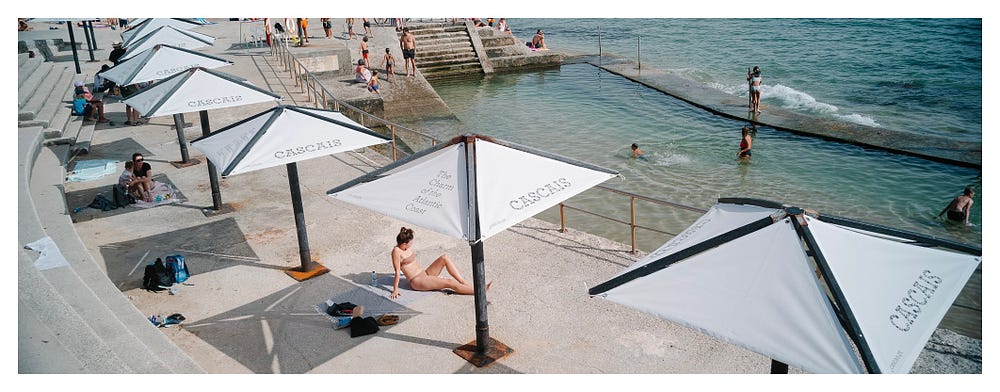
Searching for lines:
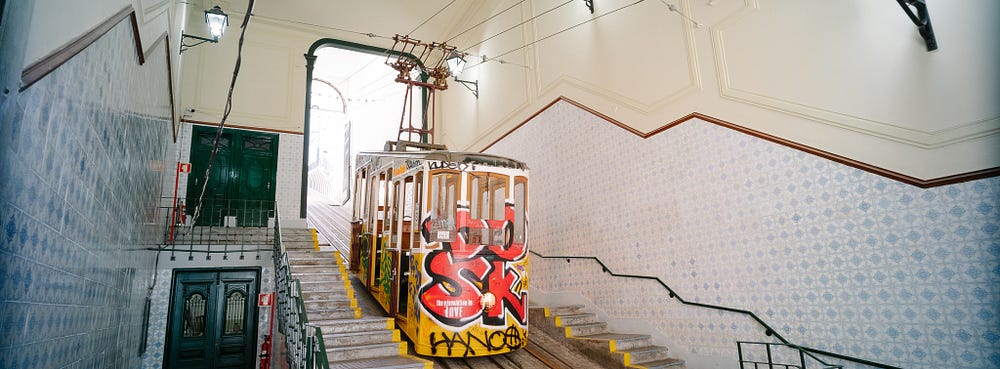
the first thing that caught my attention was the lines formed by multiple elements rising from bottom to top.
Leica 21SE+ GFX50s2 + LR12.2+TCP Portra 400 Film Preset

Often with an Xpan, capturing the entire subject/object in the frame is impossible.
It’s enough to capture the scene’s most exciting or relevant part within the frame.
Sometimes leaving something out can even provide a better space for imagination.
Leica 35mm F1.4 11874 + GFX50s2 + LR12.2+TCP Portra 400 Film Preset

and finding a spot to take a picture among the many lines becomes very interesting.
Leica 21SE+ GFX50s2 + LR12.2+TCP Portra 400 Film Preset

the rundown poles on the road and the pillars across the street have a nice aesthetic.
Leica 21SE+ GFX50s2 + LR12.2+TCP Portra 400 Film Preset
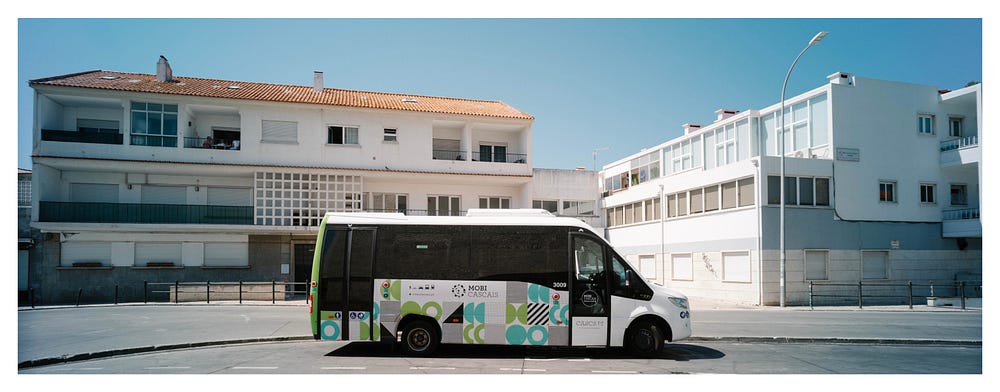
which captures ordinary scenes of American towns using “structure” instead of composition.
Stephen Shore removes the traditional photographer’s focus on perspective
and colour perspective and decentralizes the image.
Of course, the theories of a master like him cannot be easily understood or imitated overnight.
When I took this picture, I was attracted by the shapes of the buildings and cars in front of me.
Leica 35mm F1.4 11874 + GFX50s2 + LR12.2+TCP Portra 400 Film Preset

and umbrellas in front of me.
Leica 35mm F1.4 11874 + GFX50s2 + LR12.2+TCP Portra 400 Film Preset
The author observes the shapes and lines around them when taking photos, finding the appropriate composition and angle. Doing so allows them to capture the ideal image and teaches the author to see the world through the language of photography. Not every scene has an obvious formal beauty, but as long as it is discovered, it must be utilized well. The author hopes to continuously explore more interesting photographic subjects in daily life through constant experimentation.
The fun aspect of using Xpan or shooting with a wide format in street photography is the ability to experiment with additive and compositional framing.
Pano photography often uses wide-angle or ultra-wide-angle lenses, which can present a strong sense of perspective. However, if you use a wider-angle lens, you need to get closer to the subject to maintain the focus, otherwise the image may lose its focus.
For most beginners new to shooting wide-angle, having only one main subject in the photo is best.

Leica 35mm F1.4 11874+GFX50s2 + TCP Portra 400 Film Preset 2021

Start with a simple composition with the subject placed in the centre, and add other elements as needed.
Use an additive approach to add other elements into the frame slowly.
Leica 35mm F1.4 11874+GFX50s2 + TCP Portra 400 Film Preset 2021

Leica 21SE+ GFX 50s2 + TCP Portra 400 Film Preset 2021
Fishing style street photography
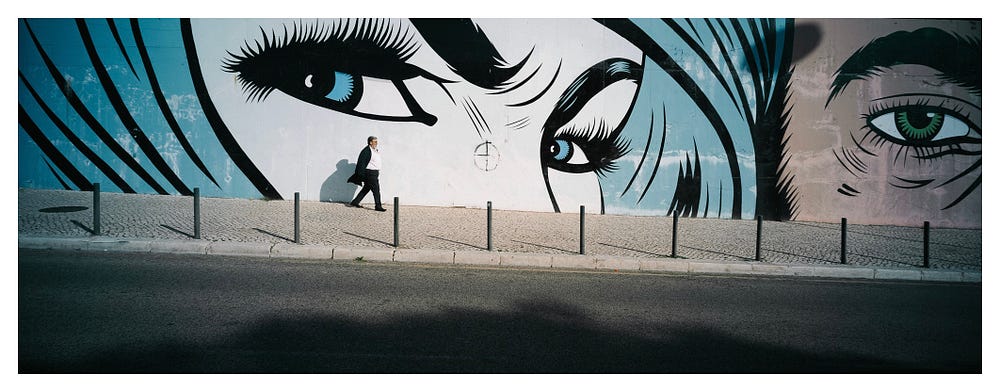
and light to pass by before pressing the shutter button.
When photographing a pedestrian walking by,
it is better if their feet are apart as it looks more visually appealing…
But this requires a bit of luck and experience!
Leica 21SE+ GFX 50s2 + TCP Portra 400 Film Preset 2021

Add an appropriate amount of negative space

Leica 21SE+ GFX 50s2 + TCP Portra 400 Film Preset 2021

Leica 35mm F1.4 11874+GFX50s2 + TCP Portra 400 Film Preset 2021
Xpan photography is something that takes time to be done. It requires the photographer to have a certain level of composition and design skills and a keen sense of observation of the shapes and structures within the scene. For the author, Xpan photography is a form of additive photography. Using all of the available space and figuring out how to arrange or balance elements is an exciting challenge and an opportunity to rediscover the beauty of photography.
You can have more than one theme or focal point.
Pano Photography differs from regular 3:2 or 4:3 aspect ratio photos in that it can arrange two or three visual focal points in the frame, making the image more layered and rich. However, when composing the shot, it is essential to consider the viewer’s reading direction and the frame size to avoid cluttered or empty images.
In Pano photography, one must also make choices and cannot include all objects in the shot. Instead, it is necessary to highlight the focal points and atmosphere in the frame, allowing the audience to have a deeper impression of the image.


or it could also mean the cultural and humanistic aspects of the community of Sai Ying Pun.”
Leica 35mm F1.4 11874 + GFX50S2 + LR12.2 + TCP Portra 400 Film Preset

Similarly, you can divide the image into two halves


Leica 21SE+ GFX 50s2 + TCP Portra 400 Film Preset 2021
The choice of lens for Pano photography depends a lot on your shooting distance
Most Pano cameras also use wide-angle lenses as their main lenses because they have a strong sense of perspective, creating some visual impact and allowing more environmental elements to be included in the shot.

After all, the optical structure of lenses with narrow apertures is much more mature.
The image circle of these lenses is usually larger, allowing for better frame coverage.
Moreover, since Pano photography often occurs between f/5.6 to f/11,
narrow-aperture lenses can easily handle such conditions.
Most SLR/rangefinder 50mm lenses can also cover the imaging circle of the GFX 4433. However, the wider the angle of the lens, the less coverage it may have… Many rangefinder 21mm/28mm lenses only cover the 4433 xpan range. The author thinks that if it’s just for shooting Xpan, then purchasing small fixed focal length lenses for SLR with F2.8-F4 is already very good, in terms of price and size…
The author mainly uses their existing Leica M lenses and a few manual Minolta lenses to shoot. They no longer pursue perfect coverage of the GFX 4433 imaging circle, as long as it covers the Xpan range, it is enough. Some limitations can help the author focus more on shooting in Xpan mode. Or perhaps the author has already exhausted their quota for playing with vintage lenses, and it’s challenging to find long-term satisfaction in playing with them. It’s better to start anew in a new environment with a new camera. Less is more, and letting go can bring gains…
A 35mm (28mm) lens for everyday street photography is a great choice.


This is mainly due to its smaller size and thinner mount than my DSLR lenses, which is also a consideration.
While the image circle of the 11874 does not completely cover the 4:3/3:2 aspect ratio,
it should be able to cover around 16:10, which still allows me to make minor adjustments in post-processing.
This is sufficient for my needs.
Having some limitations can stimulate creativity and help me focus more on capturing the moment.

Most street photography involves shooting at a distance of 2–3 meters from the subject.
Leica 35mm F1.4 11874 + GFX50s2 + LR12.2+TCP Portra 400 Film Preset

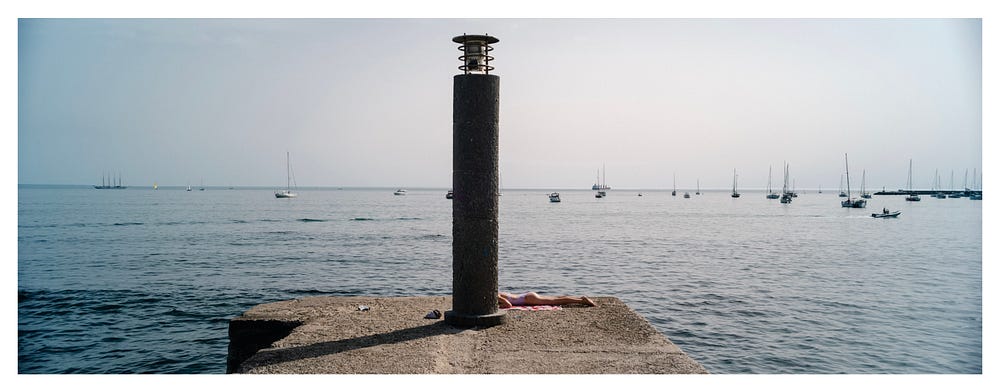
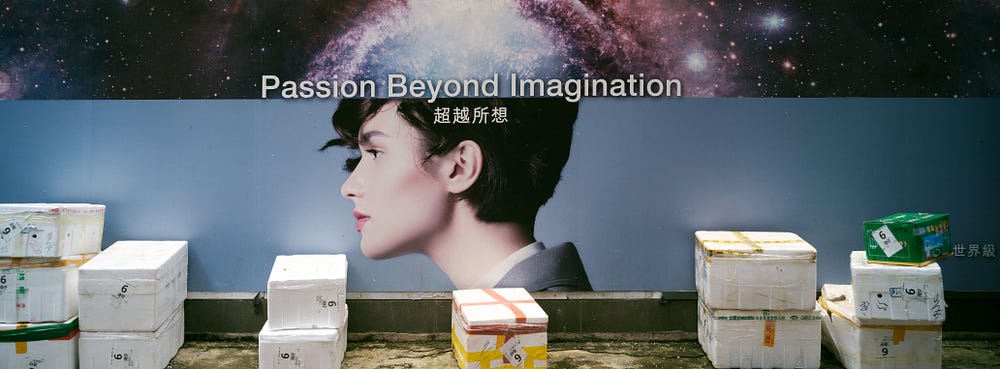
Using an ultra-wide-angle lens for photographing buildings and landscapes.
When taking photos of architecture or landscapes, I like to use ultra-wide-angle lenses of 24mm (equivalent to 19mm) or 21mm (equivalent to 16mm)… Ultra-wide-angle lenses can emphasize the lines and perspective of the buildings.


Leica 21SE + GFX50s2+LR12.2 + TCP Provia 100F Film Preset


Leica 21SE + GFX50s2+LR12.2 + TCP Provia 100F Film Preset
Perspective with the diminishing scale from foreground to background.
A 50mm equivalent to 40mm is a good choice when shooting portraits. However, using this lens for pano street photography on a GFX50s2 may produce a monotonous image with a less expansive composition. It lacks the visual tension of the Xpan wide-angle lens, which is why the Xpan’s standard lens is 45mm rather than 90mm. The Xpan’s 45mm lens equals 24mm, while 90mm is closer to 50mm.


The shooting distance was probably around 2 meters, and the vertical ratio is relatively narrow.
The advantage is that it can concentrate on the expressions and actions of the subject.
The disadvantage may be the lack of exaggerated perspective effects and less environmental description
that would be seen with a wide-angle lens.



If you move GR3x back 1–1.5 steps, you can get the same perspective as GR3,
which means you can take a similar composition or frame further with GR3x.
So why do most street photography enthusiasts choose 35mm as their most commonly used focal length? If the subject/object is standing still, you can take one step forward and get the 28mm perspective or one step back and get the 50mm perspective… I believe this should not be unfamiliar to most street photography enthusiasts.
Carl Zeiss 32mm F2.8 became my Primary lenses for GFX 50s2 Xpan Mode :





Using telephoto lenses for photography.

Minolta MD 85v.soft +GFX 50s2 + TCP Portra 400 Film Preset

which is an interesting effect that cannot be achieved with a wide-angle lens.
However, the prerequisite has enough space to move around for shooting.
Minolta MD 85v.soft +GFX 50s2 + TCP Portra 400 Film Preset


Minolta 250RF+ GFX50s2 + LR12.2 + TCP Portra 400
More photos:
Using 135mm mode as a backup plan.
The author has spent the past six months travelling to tourist areas and frequently taking pictures of various landscapes, people, buildings, and more.
The author has travelled to various tourist areas and frequently shot landscapes, people, and buildings for six months. The author’s most familiar and commonly used shooting focal length is 35mm (equivalent to 28mm). Finding a lens that can fully cover the 4:3 or 3:2 aspect ratio is best for most people. However, the wider the lens, the more difficult it is to cover the entire image circle perfectly. Therefore, using the 135mm mode for shooting may provide better edge-to-edge image quality and offer a second focal length option. Alternatively, when the author fully engages in wide-angle shooting, switching to the 3:2 mode for shooting and thinking about composition is challenging. The 135-crop mode still provides a 30mp resolution, sufficient for everyday shooting.


This way, the lens in the author’s hand will include two focal lengths, 17mm and 21mm.
Leica 21SE + GFX50S2 @135mm mode + LR12.2 + TCP Provia 100F Film Preset


Every time there is a chance to use the 4433, 135 cutting mode, APS-C, or 1-inch camera for photography.
In fast-paced environments such as street markets or indoor locations,
I prefer to use the GR3/X100V for a more low-key and convenient approach.
I also enjoy the shallow depth of field produced by the long focal length lens of the RX100m7.
Every piece of equipment has pros and cons, and I am not a spokesperson for any of them.
The author’s original intention for using the GFX50s2 has never changed: to shoot in Xpan mode.
For many photography enthusiasts, using GFX cameras is all about using 135 format lenses in a reverse configuration, mainly focusing on old lenses such as Canon tilt-shift lenses, 50mm/85mm lenses, etc. This is to achieve a 20% shallower depth of field or bokeh effect and better post-processing tolerance for landscape photography, among other benefits. When GFX50S/50R/100S were introduced, there was no impulse to purchase them, mainly because the camera body’s response was not fast enough, and the shutter lag was long. If you use it for street photography, you must adapt to the camera’s functions to take pictures. More importantly, they don’t want to be a gearhead again, wandering in the sea of different old lenses.
The author is a multi-system user, and as long as they can find the unique selling point of each brand’s equipment, it is enough for them to continue using it without being all-around. In recent years, the author’s subject matter has changed, primarily for street photography, and street photography is mainly shot with a closed aperture to achieve sufficient depth of field. The differences between lenses from manufacturers under a small aperture have become minimal, making the author less interested in playing with old lenses in recent years. A GR3/X100V is already sufficient for the author’s use, with its lightweight and low-key body, and it’s not a problem to use it for a whole day of shooting. The Sony A7R3 can be used with the auto-focus adapter to give old manual lenses a decent autofocus function. Using the Leica M10D allows the author to enjoy the pleasure of zone focusing for street photography.


The biggest impression that the GFX50s2 gives the author is its handling response and five-axis stabilization that has reached an entirely functional level. It’s almost the same as when the author uses the Sony A7R3 with manual focus… However, it feels like using a 135-format SLR camera for street photography, but the overall handling, response, and stabilization are incredibly convenient, simple, and direct. The shutter lag is very short, and it’s almost a “what you see is what you get” situation without the limitations of ISO, safe shutter speed, and continuous shooting that were present in previous medium format cameras. The author believes they could also take similar wide-angle photos with the 50R, but the success rate and shooting pleasure would be reduced. However, the second-hand price of the 50R in Hong Kong is excellent and great for adapting old lenses. However, taking the 50s2 out for shooting feels like going back to more than ten years ago when the author used the Sony A850 SLR for street photography.

The author believes the 25MP resolution is sufficient for daily Xpan mode use.
If needed, AI upscaling can enhance the resolution to 30–40MP.
However, 25MP is enough for most people to post photos on Instagram or social media.
For the author, autofocus would still be the preferred feature if the GFX camera body is upgraded to 100MP. With a higher resolution, the image quality demands would also increase, and using a closed aperture and hyperfocal distance to shoot like in the GFX50s2 may be less effective. The author expects the X2D firmware update to achieve the shooting pleasure required for street photography. The author still leans towards Hasselblad regarding lens quality, image quality, and camera colour tuning. However, the author has no confidence in Hasselblad’s autofocus capabilities. Hasselblad may take a long time to release an upgrade with an improved PDAF-focusing response, and the price may also become more affordable after a few major firmware updates. Time is always the best friend when it comes to playing digital cameras, and the author is willing to wait for the day they can purchase the X2D + XCD30 +38v+55v at a reasonable price.

Do you remember the photographer who used an entire roll of 36 135 format film to capture the Eiffel Tower?
Limitations can spark your imagination and creativity.
The surprising thing about the GFX50s2 is that its post-processing tolerance is higher than expected. The RAW files tend to be neutral and with less pronounced “Fuji black” tones, making post-processing and adjusting highlights and shadows much more ideal. Since the author mainly used the GFX50s2 for outdoor shooting in sunny weather during their trip to Portugal, the camera’s tolerance and ISO performance were more than sufficient. The author rarely needed to push the ISO above 1600.

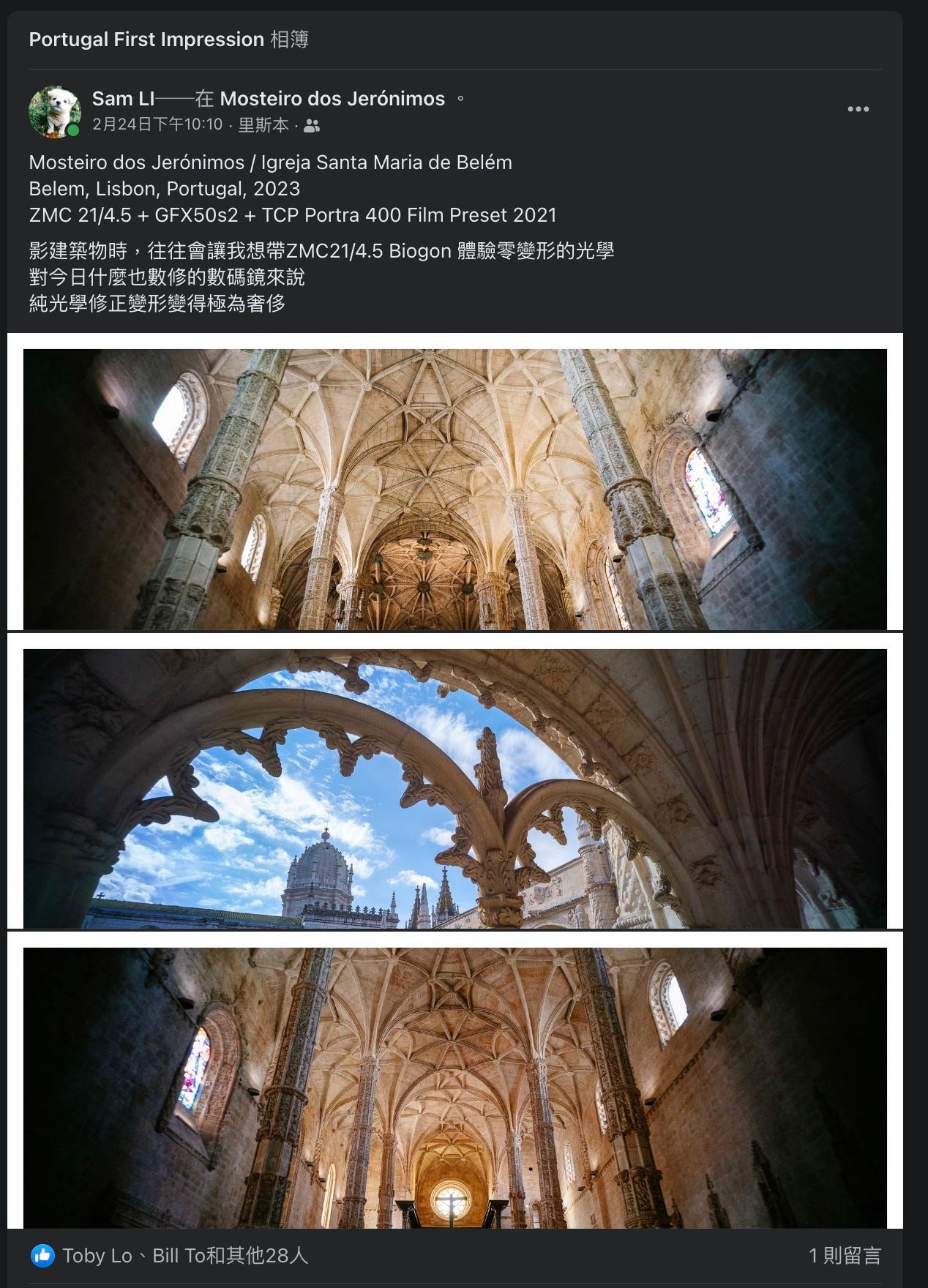
When publishing photos on social media, it’s essential to consider how to showcase them effectively.
Remember, most viewers may only have a second or less to view your photos,
so making them visually appealing and easy to understand at a glance is essential.
Summary :
Conscious observation
The threshold for shooting Pano photos is relatively low, as even using a 135/APSC camera and cropping the top and bottom of the image can achieve the effect. Pano photos can bring visual impact and a cinematic feel, which may be due to their freshness compared to 3:2 or 4:3 photos. While one or two Pano photos can easily win the admiration of others, continuous shooting may reveal that the composition can become monotonous and has certain limitations and difficulties.
The creative path of medium format/large format photography is a lonely and very personal one.
The pursuit of higher-end equipment often creates distance from the general public, and seeking the approval of the masses may not necessarily be the result you achieve.

Whether someone likes Pano photography is a very personal and intuitive choice, just as some people only like black and white photography and buy a Leica Monochrome to shoot only black and white photos or continue to use a Rolleiflex film camera for street photography with a 1x1 square composition. Some people feel that continuing to shoot with film cameras is the only pure way. There is no right or wrong, and it’s essential to trust your intuition and find subjects or methods that make you feel fulfilled and satisfied when you shoot. In other words, whether it’s 1:1, 3:2, 16:9, or 65:24, it’s just a frame to view the world, and you need to find your own visual experience within the limited framework. When entering the world of medium format photography, the process and results are primarily for self-entertainment. To achieve even a slight improvement, you must invest more money, energy, and skill; the best effect can only be seen on your home computer. Honestly, the difference in image quality between medium format and FF/APSC cameras is not significant when viewed on social media platforms like Instagram. You wouldn’t expect to see details on a 1080px x 1080px image, so hashtags like #IQ4 #Phaseone #GFX100s can make your photos look more high-end.

However, fewer photographers in the Chinese-speaking region tend to use the platform.
In Pano photography, slowing down the pace of shooting allows the author to consciously learn to use patterns and lines as a photographic language to view the world. Through observation, understanding, and imagination, the author constructs a frame and space that belongs to them.
The author’s article or reflections provide an opportunity to re-examine how they viewed the world in the past year using a Pano frame. It’s essential to take good photos and regularly review whether any subjects or elements interest you in your photography. From fragmented ideas to organizing, categorizing, and editing photos, it’s easy to take a picture that the public considers “beautiful” or Instagram-worthy today. However, constantly repeating past successful formulas may not align with the meaning and purpose of your photography. In today’s era of everyone taking photos and recording their lives through vlogs, it’s essential to consider whether your photography is keeping up with the progress of technology and the times and seeking more possibilities.
The author believes they will continue learning Pano photography in the coming years. While today’s discussion may have focused more on how to take Pano photos, the author hopes to eventually forget the technical skills and focus more on viewing the world with their heart and mind. By doing so, they can create more meaningful and impactful photos that genuinely reflect their unique perspective and vision.
More Photos:
I hope to learn new photography techniques and ways of thinking and use them even in old age.
The photos in the article are modified from TCP The Classic Film Presets 2021:
You can also get a rebate from ME through Affiliate links…
https://theclassicpresets.com/?ref=o71q594tf2
Use Coupon Code “ Rokkorx” for 15% off when paying
If you Like my reviews, please support me by buying me a coffee.

For those interested in other introductions to Portugal, please see:
If you like this article or want me to continue, please let me know that you like it too by clapping your hands a bit more.

This way, I will receive 2.27 USD per month…
https://samlee-hk.medium.com/membership
